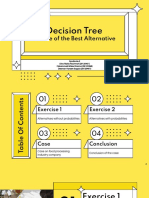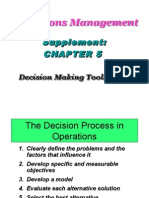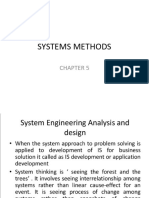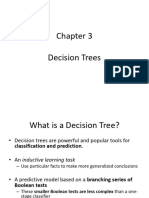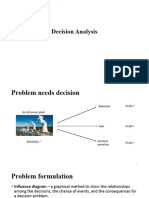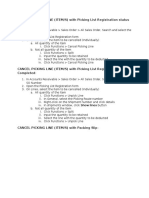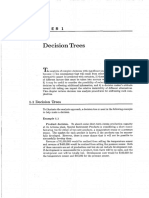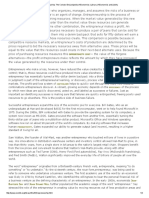0 ratings0% found this document useful (0 votes)
147 views18 pagesDee Three
Dee_Three
Uploaded by
Marjorie Mae Manaois CruzatCopyright
© © All Rights Reserved
We take content rights seriously. If you suspect this is your content, claim it here.
Available Formats
Download as PDF or read online on Scribd
0 ratings0% found this document useful (0 votes)
147 views18 pagesDee Three
Dee_Three
Uploaded by
Marjorie Mae Manaois CruzatCopyright
© © All Rights Reserved
We take content rights seriously. If you suspect this is your content, claim it here.
Available Formats
Download as PDF or read online on Scribd
You are on page 1/ 18
CHAPTERI
Decision Trees
Tie analysis of complox decisions with significant uncertainty can be confusing
because 1) the consequence that will result from selecting any specified decision
alternative cannot be predicted with certainty, 2) there are often a large number
of different factors that must be taken into account, when making the decision,
8) it may be useful to consider the possibility of reducing the uncertainty in the
decision by collecting additional information, and 4) a, decision maker’s attitude
toward risk taking can impact the relative desirability of different alternatives,
‘This chapter reviews decision tree analysis procedures for addressing such com-
plexities.
1.1 Decision Trees
‘Toillustrate the analysis approach, a decision tree is used in the following example
to help make a decision.
Example 1.1
Product decision. To absorb some short-term excess production capacity
at its Arizona plant, Special Instrument Produets is considering a short manu
Tacturing run for either of two new products, a temperature seusor or a pressure
sensor. The market for each product is known if the products can be succest-
fully developed. However, there is some chance that it will not be possible to
successfully develop them.
Revenue of $1,000,000 would be realized from selling the temperature sensor
‘and revenue of $400,000 would be realized from selling the pressure sensor. Both
of these amounts are net of production cost but do not include development cost,
If development is unsuccessful for a product, then there will be no sales, and the
development cost will be totally lost. Development cost would be $100,000 for
‘the temperature sensor and $10,000 for the pressure sensor.
2
CHAPTER 1 DECISION TREES
Development Development Sales Net
Cost uteome Revenue Proft
Suce $900,000
$100,000,
$390,000
$10,000
$0
Figure 1.1 Special Insirument Products decision
Question 1.1: Which, if either, of these products should Spe-
cial Instrument Products attempt to develop?
‘To answer Question 1.1 it is useful to represent the decision as shown in Figure
LL. The tree-like diagram in this figure is read from left to right. At the left,
indicated with a small equare, is the decision to select, among the three available
alternatives, which are 1) the temperature sensor, 2) the pressure sensor, ot 3) ne
ther. The development costs for the “develop temperature sensor” and “develop
‘pressure sensor” alternatives are shown on the branches for those alternatives.
At the right of the development costs are small circles which represent the uncer-
tainty about whether the development outcome will be a suecess or a failure. The
branches to the right of each circle show the possible development, outcomes. On
the branch representing each possible development outcome, the sales revenue is
shown for the alternative, assuming either success or failure for the development.
Finally, the net profit is shown at the far right of the tree for each possible com-
bination of development alternative and development outcome. For example, the
topmost result of $900,000 is calculated as $1,000, 000 — $100,000 = $900, 000.
(Profits with negative signs indicate losses.)
‘The notation used in Figure 1.1 will be discussed in more detail shortly, but
for now concentrate on determining the alternative Special Instrument Products
should select. We can see ftom Figure 1.1 that developing the temperature sensor
could yield the largest net profit ($900,000), but it could also yield the largest
loss ($100,000). Developing the pressure sensor could only yield 8 net profit
Ll DECISION TREES 3
cof $390,000, but the possible loss is limited to $10,000. On the other hand,
not developing either of the sensors is risk free in the sense that there is no
possibility of a loss. However, if Special Instrument Products decides not ta
attempt to develop one of the sensors, then the company is giving up the potential
opportunity to make either $900,000 or $390,000. Question 1.1 will be answered
in a following example after we discuss the criterion for making such a decision.
.
You may be thinking that the decision about which alternative is preferred de-
pends on the probabilities that development will be successful for the teraperature
or pressure sensors. This is indeed the case, although knowing the probabilities
will not by itself always make the best alternative in a decision immediately clear.
However, if the outcomes are the same for the different alternatives, and only the
probabilities differ, then probabilities alone are sufficient to determine the best
alternative, as illustrated by Example 1.2.
Example 1.2
Tossing a die. Suppose you are offered two alternatives, each of which
consists of @ single toss of a fair die, With the first alternative, you will win
$10 if any number greater than 4 is thrown, and lose $5 otherwise. With the
second alternative, you will win $10 if any number greater than 3 is thrown, and
lose $5 otherwise. In this case, since there are 6 faces on a die, the probability
of winning is 2/6 = 1/3 for the frst alternative and 3/6 = 1/2 for the second
alternative. Since the consequences are the same for both alternatives and the
probability of winning is greater for the second altemative, you should select the
second alternative. a
However, the possible outcomes are often not the same in realistic business
decisions and this causes additional complexities, as illustrated by further con-
sideration of the Special Instruments Product decision in Example 1.3.
Example 1.3
Product decision. Suppose that in Example 1.1 the probability of devel-
opment success is 0.5 for the temperature sensor and 0.8 for the pressure sensor.
Figure 1.2 is a diagram with these probabilities shown in parentheses on the
branches representing the possible outcomes for each sensor development effort.
(While only the probability of success is specified for each development effort,
the probability of failure is determined by the rules of probability since the prob-
abilities of development success and development failure must add up to one.)
A study of Figure 1.2 shows that having the probabilities does not resolve this
decision for us. The figure shows that although the probability of development
success is considerably lower for the temperature sensor than it is for the pressure
sensor (0.5 versus 0.8), the net profit from successful development of the tempera-
ture sensor is considerably higher than the net profit from successful development
4 CHAPTER 1 DECISION TREES
Development Development Sales Net
Cost Outcome Revenue Proft
_Suecess ___$1,000.000 _—g99,o90
os 7
$100,000
$390,000
$10,000
so
Figure 1.2
Special Insirument Products decision tree
of the pressure sensor ($900,000 versus $390,000). ‘That is, the alternative with
the higher potential payoff has a lower probability that this payoff will actually
be realized.
‘The resolution of this decision dilemma is addreseed in the next section,
before doing this, Definition 1.1 clarifies the notation in Figures 1.1 and 1.2.
Definition 1.
Decision tree notation
but
‘A diagram of a decision, as illustrated in Figure 1.2, is called a decision,
tree. This diagram is read from left to right. ‘The leftmost node in a
decision tree is called the root nade. In Figure 1.2, this is a small
square called a decision node. The branches emanating to the right
from a decision node represent the set of decision alternatives that are
available. One, and only one, of these alternatives can be selected. The
small circles in the tree are called chance nodes. The number shown
in parentheses on each branch of a chance node is the probability that
tho outcome shown on that branch will occur at the chance node, The
right end of each path through the tree is called an endpoint, and each
endpoint represents the final outcome of following a path from the root
node of the decision tree to that endpoint.
1.2 EXPECTED VALUE 5
Your Outcome Payment Net
Payment of Toss toYou ~ Profit
Figure 1.3
Die toss decision iree
1.2 Expected Value
In order to decide which alternative to select in a decision problem, we need
a decision criterion; that is, a rule for making a decision, Expected value is a
criterion for making a decision that takes into account both the possible outcomes
for cach decision alternative and the probability that each outcome will occur.
To illustrate the concept of expected value, we consider a simpler decision with
lower stakes than the Special Instrument Products decision.
Example 1.4
Rolling a die. A friend proposes 2 wager: You will pay her $9.00, and then a
fair die will be rolled. If the die comes up a 3, 4, 5, or 6, then your friend will pay
you $15.00. If the die comes up 1 or 2, she will pay you nothing. Furthermore,
your friend agrees to repeat this game as many times as you wish to play.
Question 1.2: Should you agree to play this game?
Tia six-sided die is fair, there is a 1/6 probability that: any specified side will
come up on a roll. Therefore there is a 4/6 (= 2/3) probability that a 3, 4, 5, or
6 will come up and you will win. Figure 1.3 shows the decision tree for one play
of this game.
At first glance, this may not look like 2 good bet since you can lose $9.00,
while you can only win $6.00. However, the probability of winning the $6.00 is
2/8, while the probability of losing the $9.00 is only 1/3. Pethaps this isn’t such
‘a bad bet after all since the probability of winning is greater than the probability
of losing.
The key to logically analyzing this decision is to realize that your friend will let
‘you play this game as many times as you want. For example, how often would you
‘expect to win if you play the game 1,500 times? Based on what you have learned
6
CHAPTER 1 DECISION TREES
about probability, you know thet the proportion of games in which you will win
over the long run is approximately equal to the probability of winning a single
game. Thus, out of the 1,500 games, you would expect to win approximately
(2/3) x 1,500 = 1,000 times. Therefore, over the 1,500 games, you would expect
to win a total of approximately 1,000 x $6 +500 x (—$9) = $1, 500. So this game
looks like a good deal!
‘Based on this logic, what is each play of the game worth? Well, if 1,500
plays of the game are worth $1,500, then one play of the game should be worth
$1,500/1, 500 = 81.00. Putting this another way, you will make an average of
$1.00 each time you play the game.
A little thought about the logic of these calculations shows that you can di-
rectly determine the average payoff from one play of the game by multiplying
each possible payoff from the game by the probability of that payoff, and then
adding up the results. For the die tossing game, this calculation is (2/3) x 86+
(1/3) x (99) = 81.
‘The quantity calculated in the manner illustrated in Example 14 is called the
expected value for an alternative, as shown in Definition 1.2. Expected value
is often a good measure of the value of an alternative since over the long run this
is the average amount that you expect to make from selecting the alternative.
Definition 1.2: Expected Value
‘The expected value for an uncertain alternative is calculated by multi-
plying each possible outcome of the uncertain alternative by its probabil-
ity, and summing the results. ‘The expected value decision criterion
selects the alternative that has the best expected value. In situations
involving profits where “more is better,” the alternative with the high-
est expected value is best, and in situations involving costs, where “less
is better,” the alternative with the lowest expected value is best.
Example 1.5
Product decision. The expected values for the Special Instrument Prod-
ucts decision are designated by “EV” in Figure 14. ‘These are determined
1s follows: 1) For the temperature sensor altemative, 0.5 x $900,000 + 0.5 x
($100, 000) = $400, 000, 2) for the pressure sensor alternative, 0.8 x $390, 000-+
0.2 x (—810,000) ='$310,000, and 3) for doing neither of these $0, ‘Thus, the
alternative with the highest expected value is developing the temperature sensor,
and if the expected value criterion is applied, then the temperature sensor should
be developed.
1.2 EXPECTED VALUE 7
Development Dexelopment Sales Net
Cost Ouicome Revenue Proft
z
$900,000
-$100,000
28 $360,000
2
- 1 evststno
\ 02) altro 0 feacae
\ Neither
\
so
Figure 1.4
Special Instrument Products decision tree, with expected ualues
Figure 1.4 illustrates come additional notation that is often used in decision
‘trees. The branches representing the two alternatives that are less preferred are
shown with crosshatching (//) on their branches, The expected value for each
chance node is designated by “EV”. Finally, the expected value at the decision
node on the left is shown as equal to the expected value of the selected alternative.
Xanadu Traders
‘We conclude this section by analyzing a decision involying international com
merce. This example will be extended in the remainder of this chapter
Example 1.6
Xanadu Traders. Xanadu Traders, a privately held U.S. metals broker, has
acquired an option to purchase one million kilograms of partially refined molyzir~
conjum ore from the Zeldavian government for $5.00 per kilogram. Molyzitco-
nium can be processed into several different, products which are used in semi-
conductor manufacturing, and George Xanadu, the owner of Xanadu Traders,
estimates that he would be able to sell the ore for $8.00 per kilogram after im-
porting it. However, the U.S. government is currently negotiating with Zeldavia
over alleged “dumping” of certain manufactured goods which that country ex:
ports to the United States. As part of these negotiations, the U.S. government,
hhas threatened to ban the import from Zeldavia of a class of materials that in-
cludes molyzirconium. If the U.S. government refuses to issue an import license
8
CHAPTER 1 DECISION TREES.
for the molyzirconium after Xanadu has purchased it, then Kanedu will have to
pay a penalty of $1.00 per kilogram to the Zeldavian government to annul the
purchase of the molyzirconium.
Xanadu has used the services of Daniel A. Analyst, a decision analyst, to help
in making decisions of thie type in the past, and George Xanadu calls on him to
aseist with this analysis. From prior analyses, George Xanadu is well-versed in
decision anslysis terminology, and he is able to use decision analysis terms in his
discussion with Analyst.
‘Analyst: As I understand it, you can buy the one million kilograms of molyzir-
conium ore for $5.00 a kilogram and sell it for $8.00, which gives a prot of
(88.00 — $5.00) x 1, 000, 000 = $3,000,000. However, there is some chance that
you cannot obtain an import license, in which case you will have to pay $1.00
pper kilogram to annul the purchase contract. In that case, you will not have
to actually take the molyzirconium and pay Zeldavia for it, but you will lose
$1.00 X 1, 000, 000 = $1, 000,000 due to the cost of annulling the contract.
Xanadu: Actually, “some chance” may be an understatement, ‘The internal
politics of Zeldavia make it hard for their government to agree to stop selling
their manufactured goods at very low prices here in the United States. The
chances are only fifty-fifty that I will be able to obtain the import license. As you
know, Xanadu Traders is not a very large company. The $1,000,000 loss would
be serious, although certainly not fatel. On the other hand, making $3,000,000
‘would help the balance sheet.
Question 1.3: Which alternative should Xanadu select?” As-
suse that Xanadu uses expected value as his decision criterion,
‘To answer this question, construct a decision tree. ‘There are two possible
alternatives, purchase the molyzirconium or don’t purchase it. If the molyzirco-
nium is purchased, then there is uncertainty about whether the import license
will be issued or not. The decision tree is shown in Figure 1.5. Starting from the
root node for this tree, it costs $5 million to purchase the molyzirconium, and if
the import license is issued, then the molyzirconium will be sold for $8 million,
yielding 2 net profit of $3 million. On the other hand, if the import license is not
sued then Xanadu will recover $4 million of the $5 million that it invested, but
‘will lose the other $1 million due to the cost of anculing the contract.
‘The endpoint net profits are shown in millions of dollars, and the expected
value for the “purchase” alternative is 0.5 x $3 +0.5 x ($1) = 81, in millions
of dollars. Therefore, if expected value is used as the decision criterion, then the
proferred alternative is to purchase the molyzirconium. Mj
Purchase oe
1.3 DEPENDENT UNCERTAINTIES 9
Cost Import License Revenue Net
Issued? Proft
Purchas:
Donit
Figure 1.5
Xanadu Traders initial decision tree (dollar amounts in millions)
1.3 Dependent Uncertainties
In this section, we consider an additional complexity that often occurs in business
decisions: dependent uncertainties. Specifically, we will examine a case that
illustrates this complexity of real world decisions, end review a procedure for
analyzing decisions that include dependent uncertainties.
Example 1.7
Xanadu ‘Traders. This is a continuation of Example 1.6. We now consider
an expanded version of the decision that includes dependent uncertainties and
extend the anelysis procedure to handle this new issue, We continue to follow the
discussion between Daniel Analyst and George Xanadu that started in Example
16.
Analyst: Maybe there is a way to reduce the risk. As I understand it, the
reason you need to make a quick decision is that Zeldavia has also offered this
deal to other brokers, and ono of them may take it before you do. Is that really
very likely? Perhaps you can apply for the import license and wait until you
know whether it is approved before closing the deal with Zeldavia,
Xanadu: That's not very likely. Some of those brokers are pretty big operators,
and dropping $1,000,000 wouldn't make them lose any sleep. T'd say there is @
0.70 probability that someone else will take Zeldavia’s offer if I wait until the
import license comes through. Of course, it doesn’t cost anything to apply for
an import license, so maybe it is worth waiting to see what happens. .
10 CHAPTER 1 DECISION TREES
Cost Import License Siill_— Cost ‘Revenue Net
Issued? Available? Proft
) $0
Figure 1.6
‘Xanadu Traders revised decision tree, with expected values
‘Question 1.4: Should Xanadu ‘Traders wait to see if an import
license is issued before purchasing the molyzirconium?
‘The decision tree for this revised problem is shown in Figure 1.6. The two
alternatives at the top of this tree (“purchase” and “don’t purchase”) are the sazne
as the alternatives shown in Figure 1.5. The third alternative (“wait”) considers
‘the situation where Xenadu waits to see whether it can obtain an import licens
before purchasing the molyzirconium. This alternative introduces a new analysis
issue that must be addressed before the expected value for this alternative can
bbe determined. This new issue concems the fact that there are two stages of
‘uncertsinty for this alternative. First, the issue of an import license is resolved,
and then there is a further uncertainty about whether the molyzirconium will
still be available.
Question 1.5: What is the expected value for the “wait” al-
ternative?
‘The process of determining the expected value for this alternative involves two
stages of calculation. In particular, it is necessary to start at the right side of the
decision tree, and carry out successive calculations working toward the root node
of the tree. Specifically, first determine the expected value for the altemative
assuming that the import license is issued, and then use this result to calculate
14 SEQUENTIAL DECISIONS 11
the expected value for the “wait” alternative prior to learning whether the import
license is issued.
Examine Figure 1.6 to see how this calealation process works. As this Sgure
shows, if the import license is issued, then there is a 0.3 probability that the
molyzirconium will still be available. In this case, Xanadu will pay $5 million
for the molyzirconium, and sell it for $8 million realizing $8 million in net profit.
| If the molyzitconium is not still available, then Xanadu will not have to pay
anything and will realize no net profit. Thus, the expected value for the situation
| after the uncertainty about the import license has been resolved is 0.3 x$3-+0.7%
$0 = $0.9. This expected value is shown next to the lower right chance node on
the decision tree in Figure 1.6
From the discussion regarding expected value in Section 1.2, it follows that
this $0.9 million is the value of the alternative once the result of the iraport
license application is Imown. Hence, this value should be used in the further
expected value caleulation needed to determine the overall value of the “wait”
alternative, Tus, the expected value for the “wait” alternative is given by 0.5 x
$0.9 + 0.5 x $0 = $0.45. This expected value is shown next to the lower left
chance node on the decision tree in Figure 1.6. Since the expected value for the
“wait” alternative is less than the $1 million expected value for purchasing the
molyzirconium right now, this alternative is less preferred then purchasing the
molyzirconium right now. Xanadu should not wait, assuming that expected value
is used as the decision criterion. im
‘The process of sequentially determining expected values when there are depen-
dent uncertainties in a decision tree, as demonstrated in Example 1.6, is called
decision tree rollback. This term is defined in Definition 1.3.
Definition 1.3: Decision Tree Rollback
‘The process of successively calculating expected values from the end
| points of the decision tree to the root node, as demonstrated in this
section, is called a decision tree rollback.
1.4 Sequential Decisions
In addition to dependent uncertainties, real business decisions often include se~
‘quential decisions. This section considers an exemple that demonstrates how
to address sequential decisions.
R
CHAPTER 1 DECISION TREES
Example 1.8
ABC Computer Company. ABC Computer Company is considering sub-
mission of a bid for a government contract to provide 10,000 specialized computers
for use in computer-aided desiga. There is only one other potential bidder for
this contract, Complex Computers, Inc., and the low bidder will receive the con-
tract. ABC's bidding decision is complicated by the fact that ABC is currently
‘working on a new process to manufacture the computers. If this process works a3
hoped, then it may substantially lower the cost. of meking the computers. How-
fever, there is some chance that the new process will aciually be more expensive
than the current manufacturing process. Unfortunately, ABC will not be able to
determine the cost of the new process without actually using it to manufacture
the computers.
IE ABC decides to bid, it will make one of three bids: $9,500 per computer,
$8,500 per computer, or $7,500 per computer. Complex Computers is certain
to bid, and it is equally likely that Complex will bid $10,000, $9,000, or $8,000
per computer. If ABC decides to bid, then it will cost $1,000,000 to prepare the
bid due to the requirement that a prototype computer be included with the bid.
This $1,000,000 will be totally lost regardless of whether ABC wins or loses the
bidding competition,
With ABC's current manufacturing process, it is certain to cost $8,000 per
computer to make each computer. With the proposed new manufacturing process,
there is 6 0.25 probability that the manufacturing cost will be $5,000 per computer
and a 0.50 probability that the cost will be $7,500 per computer, Unfortunately,
‘there is also a 0.25 probability that the cost will be $8,500 per computer.
Question 1.6: Should ABC Computer Company submit a bid,
and if so, what should they bid per computer?
A decision tree for this situation is shown in Figure 1.7. First, ABC must
decide whether to bid and how much to bid. If ABC's bid is lower than Complex
Computer's, then ABC must decide which manufacturing process to use. If ABC
uses the proposed new manufacturing process, then the cost of manufacturing
the computers is uncertain. The net profit figures (in millions of dollars) shown
at the endpoints of the Figure 1.7 tree take into account the cost of preparing
the bid, the cost of manufacturing the computers, and the revenue that ABC will
receive for the computers. For example, examine the topmost endpoint value. It
costs $1 million to prepare the bid, and ABC bids $9,500, which is lower than
Complex Computers’ bid of $10,000, and hence ABC wins the contract, Then the
proposed new manufacturing process is used, and it costs $8,500 per computer
to manufacture the 10,000 computers. Therefore, at this endpoint, ABC makes a
net profit of —1, 000,000 — 10, 000 x $8, 500 +10, 000 x 89, 500 = $9, 000, 000 = $9
14 SEQUENTIAL DECISIONS 13
ABC ‘Complex Manufacturing Cost Per Net
Bid Bid Process: Computer Profit
$8,500 _
(14) $9
527.500
EvsS22.75 (112) _$5,000
rent ___$8.000
s19
sta
St
st
59
Ev=$12.75
$4
$1
\ S850 64
st
'$10,0001$9,000
$8,009
se
x Ev=$2.75
$6
Bid »
Figure L7
‘ABC Computer Company decision tree, with met profit in millions of dollars
million, Verify the net profits shown at the other endpoints so that you better
‘understand this process
Calculating the expected values shown on the Figure 1.7 decision tree requires
addressing a new issue, namely what to do when there are multiple decision nodes
in the tree. In this decision, the amount of the bid is the first decision, and if
this is lower than the Complex Computers bid, then there is a second decision
involving the type of manufacturing process to use. The calculation procedure
for this situation is a straightforward extension of the calculation procedure that
was demonstrated in the preceding section for dependent uncertainties.
This procedure will be illustrated by considering the topmost set of nodes
in the Figure 1.7 tree. Start at the rightmost side of the tree, and calculate
the expected value for the top rightmost chance node. This is determined as
14 CHAPTER 1 DECISION TREES
(1/4) x 89 + (1/2) x $19 + (1/4) x $44 = 822.75. At the top rightmost decision
node, compare the expected values for the two branches. The expected value for
the top branch of this decision node is $22.75, and (since there is no uncertainty
regarding the cost of the current manufacturing process) the expected value for
the bottom branch is $14. Since the top branch has the higher expected value, it
is the preferred branch. That is, the proposed new manufacturing process should
be used. Hence, the expected value for the “manufacturing process” decision
node is equal to the expected value for the proposed new manufacturing process,
which is $22.75.
Now continue back toward the root of the decision tree by calculating the
‘expected value for the top leftmost chance node in the tree. Since the expected
value of the manufacturing process decision is $22.75, and there is no uncertainty
about the net profit if ABC loses the bid, the expected value for the top leftmost
chance node is (1/3) x $22.75 + (2/3) x (—S1) = $6.92.
‘A similar process is used to calculate the expected values for the other three
‘branches of the root node, and the results are shown in Figure 1.7. These cal-
culations show that an $8,500 bid has the higheet expected value, which is $8.17
million, Hence, if ABC uses expected value as its decision criterion, then it
should bid $8,500. In addition, the calculations also show that ABC should use
the proposed new manufacturing process if it wins the contract, The less pre-
ferred branches for each decision node have been indicated on the decision tree
with ross hatching.
‘The complete specification of the alternatives that should be selected at all
decision nodes in a decision tree is called a decision strategy.
Definition 1.5: Decision Strategy
Co,
‘The complete specification of all the preferred decisions in a sequential |
decision problem is called the decision strategy. The decision strategy
shown in Figure 1.7 can be summarized as follows: Bid $8,500, and if
‘you win the contract use the proposed new manufacturing process.
1.5 Exercises
ad
Arthrodax Company has been approached by Ranger Sound with e rush order
‘offer to purchase 100 units of ¢ customized version of Arthrodax’s SoundScreamer
audio mixer at $5,000 per unit, and Arthrodax needs to decide how to respond.
The electronic modifications of the standard SoundScreamer needed for this cus-
tomized version are straightforward, but there will be a fixed cost of $100,000
to design the modifications and sot up for assembly of the custoraized Sound-
Screamers, regardless of the number of units produced. It will cost $2,000 per
1.2
13
15 EXERCISES 15
unit to manufacture the circuit boards for the units. Since Arthrodax has some
short term spare menufocturing capacity, the Ranger offer is potentially attrac-
tive. However, the circuit boards for the customized units will not fit into the
standard SoundScreamer case, and Arthrodax must decide what to do about act
quiring cases for the customized units as it decides whether to accept Ranger's
purchase offer. An appropriate case can be purchased at $500 per case, but
Arthrodax could instead purchase an injection molder to make the cases. Tt will
cost $20,000 to purchase the moléer, and there is a 0.6 probability that it will be
possible to successfully make the cases using the molder. If the molder does not
work, then the purchase price for the molder will be totally lost and Arthrodax
rust still purchase the cases at $500 per case. If the molder works, then it will
cost $60 per case to make the cases using the molder. Regardless of which case is
used, the cost of assembling the SoundSereamer circuit boards into the case is $20
per unit. Unfortunately, there is no way to test the molder without purchasing
it. Assume that there is no other use for the molder except to make the cases for
the Ranger order.
(i) Draw a decision tree for Arthrodax’s decision about whether to accept the
Ranger offer and how to acquire the cases for the customized SoundScream-
(ji) Using expected net profit as the decision criterion, determine the preferred
course of action for Arthrodax.
This is a continuation of Exercise 1.1. Assume that all information given in that
exercise is still valid, except as discussed in this exercise. Ranger now tells Arthro-
ax that there is uncertainty about the number of customized SoundScreamers
that will be needed. Specifically, there is a 0.35 probability that it will need 100
units, and a 0.65 probability that it will need 50 units. If Arthrodax will agree
now to produce either number of units, then Ranger will pay $6,000 per unit if it
ultimately orders 60 units, and will pay $5,000 per unit if it ultimately orders 100
units, The timing is such on this rush order thet Arthrodax will have to make a
decision about purchasing the injection molder before it knows how many units
Ranger will take. However, Arthrodax will only need to purchase or manufacture
the number of circuit boards and cases needed for the final order of either 60 or
100 units
(@) Draw @ decision tree for Arthrodax's decision about whether to accept the
Ranger offer and how to acquire the cases for the customized SoundScream-
ers, Note that this is a situation with dependent uncertainties, as discussed
in Section 1.3.
(Gi) Using expected net profit as the decision criterion, determine the preferred
‘course of action for Arthrodax.
‘This is a continuation of Exercise 1.2. Assume that all information given in
that exercise is still valid, except as discussed in this exercise, Assume now that
Arthrodax could delay the decision about purchasing the injection molder until
after it knows how many units Ranger will take.
16
CHAPTER 1 DECISION TREES
14
15
(i) Draw a decision tree for Arthrodax’s decision about whether to accept the
Ranger offer and how to acquire the cases for the custornized SoundScream-
ers. Note that this is a situation with sequential decisions, as discussed in
Section 1.4.
(Gi) Using expected net profit as the decision criterion, determine the preferred.
couse of action for Arthrodax.
‘Aba Manufacturing has contracted to provide Zy2 Blectronics with printed circuit
(“PC”) boards under the following terms: (1) 100,000 PC boards will be delivered
to Zyz in one month, and (2) Zyz has an option to take delivery of an additional
100,000 boards in three months by giving Aba 30 days notice. Zyz will pay $5.00
for each board that it purchases, Aba manufactures the PC boards using a batch
process, and manufacturing costs are as follows: (1) there is a fixed setup cost
‘of $250,000 for any manufacturing batch run, regardless of the size of the run,
and (2) there is a marginal manufacturing cost of $2.00 per board regardless of
the size of the batch rum. Aba must decide whether to manufacture all 200,000
PC boards now or whether to only manufacture 100,000 now and manufacture
‘the other 100,000 boards only if Zyz exercises its option to buy those boards. If
Aba manufactures 200,000 now and Zyz. does not exercise its option, then the
‘manufacturing cost of the extra 100,000 boards will be totally lost. Aba believes
there is a 50% chance Zyx will exercise its option to buy the additional 100,000
PC boards.
(i) Explain why it might potentially be more profitable to manufacture all
200,000 boards now.
(li) Draw a decision tree for the decision that Aba faces.
(Gi) Determine the preferred course of action for Aba assuming it uses expected
profit as its decision criterion.
‘Kezo Systems has agreed to supply 500,000 PC FAX systems to ‘Tarja Stores in 90
days at a fixed price. A key component in the FAX systems is a programmable
array logic integrated circuit chip (“PAL chip”), one of which is required in
each FAX system. Kezo has bought these chips in the past from an American
chip manufacturer AM Chips. However, Kezo has been approached by a Korean
manufacturer, KEC Electronics, which is offering a lower price on the chips. This
offer is open for only 10 days, and Kezo must decide whether to buy some or all
of the PAL chips from KEG. Any chips that Kezo does not buy from KEC will be
ought from AM. AM Chips will sell PAL chips to Kezo for $3.00 per chip in any
quantity. KEC will accept orders only in multiples of 250,000 PAL chips, and is
offering to sell the chips for $2.00 per chip for 250,000 chips, and for $1.50 per chip
in quantities of 500,000 or more chips. However, the situation is complicated by
‘a dumping charge thet has been filed by AM Chips against KEC. If this charge
is upheld by the U. S. government, then the KEC chips will be subject to an
antidumping tax. This case will not be resolved until after the point in time
when Kezo must make the purchase decision. If Kezo buys the KEC chips, these
‘will not be shipped until after the antidumping tax would go into effect and the
chips would be subject to the tax. Under the terms offered by KEC, Kezo would
have to pay any antidumping tax that is imposed. Kezo believes there is a 60%
16
LS EXERCISES 17
chance the antidumping tax will be imposed. If it is imposed, then it is equally
likely that the tax will be 50%, 100%, or 200% of the sale price for each PAL
chip.
() Draw 2 decision tree for this decision,
(8) Using expected value as the decision criterion, determine Kezo's preferred
ordering alternative for the PAL, chips.
Intermodular Semiconductor Systems case. The Special Products Divi-
sion of Intermodular Semiconductor Systems has received a Request for Quo-
tation from Allied Intercontinental Corporation for 100 deep sea. semiconductor
clectrotransponders, a specialized instrument used in testing undersea engineered
structures. While Intermodular Semiconductor Systems has never produced deep
sea electrotransponders, they have manufactured subsurface towed transponders,
and it is clear that they could make an electrotransponder that meets Allied’s
specifications. However, the production cost is uncertain due to theit lack of
experience with this particular type of transponder. Furthermore, Allied has also
requested a quotation from the Undersea Systems Division of General Blectrode-
vices. Intermodular Semiconductor Systems and General Electrodevices are the
only companies capable of producing the clectrotransponders within the time
frame required to meet the construction schedule for Allied’s new undersea habi-
tat project
Mack Reynolds, the Manager of the Special Products Division, must de-
cide whether to bid or not, and if Intermodular Semiconductor Systems does
submit a bid, what the quoted price should be, He has assembled a project team
consisting of Elizabeth Iron from manufacturing and John Traveler from market-
ing to assist with the analysis. Daniel A. Analyst, # consulting decision analyst,
hhas also been called in to assist with the analysis.
‘Analyst: For this preliminary analysis, we have agreed to consider only @
small number of different possible bids, production costs, and General Blectrode-
vices bids
Reynolds: Thet’s correct. We will look at possible per-unit bids of $3,000,
$5,000, and $7,000. We will look at possible production costs of $2,000, $4,000,
and $6,000 per unit, and possible per-unit bids by General Electrodevices of
84,000, $6,000, and $8,000.
Iron: There is quite a bit of uncertainty about the cost of producing the
electrotransponders. I'd say there is a 50% chance we can produce them in 2
‘volume of 100 units at $4,000 per unit. However, that still leaves a 50% chance
‘that they wall either be $2,000 or $6,000 per unit
‘Analyst: Is one of these more likely than the other?
Tron: No. It’s equally likely to be either $2,000 or $6,000. We don't have
much experience with deep sea transponders. Our experience with subsurface
towed transponders is relevant, but it may take some effort to make units that
hold up to the pressure down deep. I'm sure we can do it, but it may be expensive.
Analyst: Could you do some type of cosi-plus contract?
18
CHAPTER 1 DECISION TREES
Reynolds: No way! This isn’t the defense business. Once we commit, we
have to produce at a fixed price, Allied would take us to court otherwise. They're
tough cookies, but they pay their bills on time.
lion: I want to emphasize that there is no problem making the elec-
trotransponders and meeting Allied’s schedule. The real issue is what type of
material we have to use to take the pressure. We may be ablo to use molyalu-
minuz like we do in the subsurface towed units in which case the cost will be
lower. If we have to go to molyzirconium, then it will be more expensive. Most
likely, we will end up using some of each, which will put the price in the middle.
Analyst: What is General Blectrodevices likely to bid?
‘Traveler: ‘They have more experience than we do with this sort of product.
‘They have never made deep sea electrotransponders, but they have done a variety
of other deep sea products. I spent some time with Elizabeth discussing their
experience, and also reviewed what they did on a couple of recent bids. Td sey
‘there is a 50% chance they will bid $6,000 per unit. If not, they are more likely
to bid low than high—there is about a 35% percent chance they will bid $4,000
per unit,
‘Analyst: So that means there is 15% chance they will bid $8,000.
‘Traveler: Yes.
Reynolds: Suppose we had a better handle on our production costs.
‘Would that give us more of en idea what General Electrodevices would bid?
Iron: No. ‘They use graphite-based matorials to reinforce their transpon-
ders. The cost structure for that type of production doesn’t have any relationship
to our system using moly alloys.
(i) Draw a decision tree for the decision that Reynolds must make.
(ii) Determine the expected values for each of the alternatives, and specify
which alternative Reynolds should select if he uses expected value as a
decision criterion,
You might also like
- Decision Making: Real - Rule - Rupal - Sayson - SenicaNo ratings yetDecision Making: Real - Rule - Rupal - Sayson - Senica97 pages
- Tools For Financial Decision Making: Decision Trees: Session 5No ratings yetTools For Financial Decision Making: Decision Trees: Session 523 pages
- Chapter 2 FYP 40503 Life Cycle Analysis - Decision AnalysisNo ratings yetChapter 2 FYP 40503 Life Cycle Analysis - Decision Analysis23 pages
- S04.s1 Practice Material - Payment Matrices - Decisions Under Uncertainty - Decision TreesNo ratings yetS04.s1 Practice Material - Payment Matrices - Decisions Under Uncertainty - Decision Trees5 pages
- Decision Analysis - Risk and Reliability For EngineersNo ratings yetDecision Analysis - Risk and Reliability For Engineers10 pages
- CANCEL PICKING LINE (ITEM/S) With Picking List Registration Status ActivatedNo ratings yetCANCEL PICKING LINE (ITEM/S) With Picking List Registration Status Activated1 page










